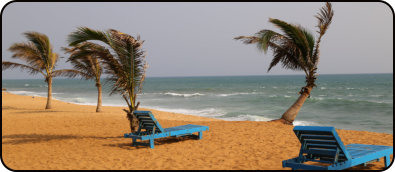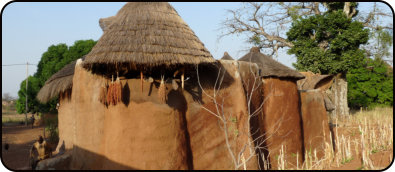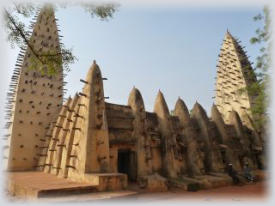


Burkina/Togo/Benin: Mud Palaces and Voodoo Ceremonies
They are West Africa's most exciting, ambitious buildings. The decoratred houses of the Kassena, the fortress-like compounds of the
Somba and Tamberma, the royal palaces of Dahomey and the sugarloaf minarets of Bobo Dioulasso’s Great Mosque. Every single
structure is unique in style, its colours reflecting the brown, ochre and red of the African soil. From the inland Sahel to the former
Slave Coast, from grassland to cocos groves, from ancient mosques to colonial churches and voodoo ceremonies - following old
trading routes, this tour reveals the diversity, sounds and sights of the “Real Africa”!
Day 1: Arrival at Ouagadougou Airport
Meet and greet with your tour leader and transfer to the hotel (5 km).
(-/-), Overnight at Ouagadougou, Hotel Le Grand Calao or similar
Day 2: Ouagadougou
In the morning, your tour leader will brief you about the trip. Next,
embark on a sightseeing tour of Ouagadougou, Burkina’s modern and
vibrant capital. Visits include the 1930s cathedral, a traditional bronze
workshop and the Village Artisanal, an artisan centre on the outskirts of
the city, dedicated to the skill and artistry of hundreds of local craftsmen.
This afternoon, you will visit the small village of Laongo just outside the
capital. Here you will find the Sculpture Park, where internationally
renowned artists have engraved their works in granite, and the Opera
Village project of the late German film director Christoph Schlingensief,
two important cultural centres of the country. We'll return to the hotel in
the early evening. (approx. 90 km)
(B/D) Overnight at Ouagadougou, Hotel Le Grand Calao or similar
Day 3: Ouagadougou - Bobo Dioulasso
Today we leave Ouagadougou and its friendly people behind and carry
on towards Bobo Dioulasso, Burkina‘s second largest city. En route,
you’ll get your first glimpse of strange-looking baobabs, huge mango
trees and traditional village life. In Sabou you‘ll meet the sacred
crocodiles. Legend has it that once a crocodile saved a hunter‘s life.
Since then, crocodiles are considered sacred by the locals. We‘ll arrive
at Bobo Dioulasso in the afternoon, in time to explore the famous
Sudanese-stype mosque and the city‘s old quarters. You may have time
to see the atmospheric central market, the Catholic cathedral and the
train station, which is a splendid example of French colonial architecture
(370 km).
(B/D), Overnight at Bobo Dioulasso, Hotel Auberge or similar
Day 4 - Bobo Dioulasso - Banfora
Today we continue into the lush forest savanna of Southwestern Burkina
Faso. After one and a half hours we reach Banfora, the pleasant capital
of this region. Upon arrival, explore the stunning surroundings of this
town set in beautiful scenery of sugar-cane fields and tree-lined hills.
The highlight of this day are the magnificent rock formations of the
Dômes de Fabédougou and the picturesque Karfiguela waterfall
(approx.100 km).
(B/D), Overnight at Banfora, Hotel Canne à Sucre or similar
Day 5: Banfora
Day excursion to the village of Sindou, reached by a newly improved
road, which we follow from Banfora for about 50 km. The area is known
for its craggy chain of castle-like rock formations, left behind when the
surrounding softer rocks eroded away. Spend some hours walking
through this tranquil wonderland of rocks. In the afternoon boatmen take
us out on to the lake Tengrela, a great location for hippo-spotting and
bird watching (approx. 100 km).Note: There is currently a travel warning
for the border area to Mali (as of October 2020). If Sindou is not
passable, we offer a substitute programme.
(B/D), Overnight at Banfora, Hotel Canne à Sucre or similar
Day 6: Banfora - Gaoua
Heading east to Gaoua, we reach the land of the Lobi and spend the day
with a local guide to learn more about the animist culture of these
people. En route, explore the mysterious ruins of Loropeni, a UNESCO
World Heritage site since 2009. In the nearby village of Obiré you‘ll meet
the local king of the Gan people. The Gan are one of the six Lobi sub-
ethnic groups and the only one to have a king. One of the king‘s wives
will show you the memorial for the deceased kings and queens. This
afternoon you‘ll reach Gaoua.Before check-in at the hotel, get a final
glimpse of Lobi artifacts and historical photographs at the well-kept
museum of Gaoua, set up by French anthropologist Madeleine Père
(approx. 220 km).
(B/D), Overnight at Gaoua, Hotel Hâla or similar
Day 7: Gaoua - Leo
After breakfast, you will spend some time in a Lobi settlement to meet
the locals and explore their fortress-like houses. They still adhere to
many of their traditional customs and animist practices, worshipping
wooden fetishes and continuing to hold fast to their age-old beliefs. In
the afternoon you‘ll depart Gaoua heading to the town of Leo. Enjoy the
last rays of sunshine of the day at the magnificent pool of our hotel.
(approx. 205 km).
(B/D), Overnight at Leo, Hotel Sissilis or similar
Day 8: Leo - Ouagadougou
This morning you‘ll return to Ouagadougou, Burkina’s modern and
vibrant capital. In the afternoon, explore Manega museum, in a rural
setting about 50 km north of Ouagadougou, hosting one of the country´s
best ethnological collections including centuries-old masks and musical
instruments as well as items of clothing from Burkina Faso's various
ethnic groups. In addition, traditional dwellings of the Mossi, Kassena,
Peulh and Bobo have been reconstructed in an open-air museum.
(approx. 235 km).
(B/D) Overnight at Ouagadougou, Hotel Le Grand Calao or similar
Day 9: Ouagadougou - Dapaong
This morning will be an early start to be begin our journey into Togo. The
first part of our drive is through the region where the Gourmantche
people reside. In the early afternoon you‘ll reach the town of Dapaong in
Togo, some 40 km from the border. We'll stop for a lunch break at our
hotel before exploring the nearby caves Grottes de Nano. Hidden among
high cliffs and lush vegetation they used to serve as a shelter for the
local population in uncertain times. Here they found refuge and
numerous granaries ensured that they could stay there for weeks. We‘ll
return to Dapaong in the evening. (approx. 330 km).
(B/D) Overnight at Dapaong, Campement de Dapaong or similar
Day 10:
Dapaong -
Natitingou
We'll depart
Dapaong after
breakfast, and
travel on to the
region where the
Tamberma people
reside. We‘ll stop
at a Tamberma
village, beautifully
set in Atacora
Mountains. This
chain of
mountains starts
in southeast
Ghana and cuts
through Togo and
Benin. We visit a
number of medieval-castle-like houses of this extraordinary tribal group.
The cultural landscape of Koutammakou has been designated as a
UNESCO World Heritage Site in 2004. Later today, we‘ll cross into
Benin. Here we will have the chance to meet the Somba people, close
relatives of the Tamberma. Similar to the Tamberma architecture, the
Somba houses also resemble castle-like fortifications which are often
flanked by small altars. (approx. 230 km)
(B/D), Overnight at Hotel Tata Somba or similar
Day 11: Natitingou - Abomey
Heading towards Abomey, take a stroll through Tanéka, one of the
fascinating Yom villages spread around the scenic landscapes near
Djougou. The Yom are closely related to the Somba and, like them,
have kept their tribal traditions alive. Further south, stop off to visit
Dankoli, considered to be the most important fetish in West Africa. This
phallus-shaped tree-trunk stained with sacrificial blood is considered to
be West Africa’s most powerful fetish with hundreds of believers arriving
every day from all over Benin and neighbouring countries. They make
their requests to the gods hammering wooden pegs into the fetish,
pouring palm-oil on to it and spitting specially made rum at the stake. If
the wishes comes true, the person must return and make the necessary
sacrifices. Otherwise he will face the consequences…. You‘ll arrive at
Abomey by late afternoon. (approx. 450 km).
(B/D) Overnight at Abomey, Hotel Guedevy I or similar
Day 12: Abomey - Ganvié - Ouidah
This morning visit the Royal Palaces of the pre-colonial kingdom of
Dahomey. This UNESCO World Heritage site houses a historical
museum and a craft centre. From Abomey continue to the stilt village of
Ganvié which – for obvious reasons - has been called the “Venice of
Africa”. It can only be reached by boat. Enjoy the exotic sight of busy
waterways, floating markets and thatched-roofed houses perched over
the water. Towards evening arrive at Ouidah, Benin´s capital of voodoo
(approx. 150 km).
(B/D) Overnight at Ouidah, Hotel Diaspora or similar
Day 13: Ouidah - Grand Popo
At Ouidah learn more about the history of slavery and the mysterious
rituals of voodoo. Take a walk along the slave route, from the slave
market to the beach where the unfortunate victims were loaded aboard
the ships, and visualize their last trek on African soil. Stop also by the
Python Temple dedicated to the ancient snake cult and, in the Sacred
Forest, get acquainted with the concepts of voodoo. For a first-hand
voodoo experience, we continue to Grand Popo to witness a
spectacular dancing ceremony of the Zangbeto, the “Guardians of the
Night” protecting the community against thieves and evil forces. The
Zangbeto masks resemble haystacks swirling around the ceremony
place. Be prepared for a magical spectacle accompanied by the
hypnotic beat of the drums! (approx. 50 km).
(B/D), Overnight at Grand Popo, Hotel Awale Plage or simillar
Day 14: Grand Popo
You have a day at your leisure to relax on the beach or at the swimming
pool of your hotel. You may join an optional pirogue ride on the Mono
River, leading you to the King’s Mouth (“Bouches du Roi”) estuary
where the river meets the ocean. Its banks are lined with sand dunes,
palm trees, patches of mangroves and little fishing villages constructed
with the branches of palm trees.
(B/D), Overnight at Grand Popo, Hotel Awale Plage or similar
Day 15: Grand Popo - Lomé
Today we head west crossing into Togo. Via Aneho we reach Lake Togo
where we take a pirogue trip to Togoville. Explore the town’s impressive
cathedral built under German colonial rule and the animist quarter,
where you will be met by a famous voodoo priestess. Later in the
afternoon we continue to Lomé, Togo’s coastal capital. In the afternoon
you will witness a stunning voodoo ceremony, a Knife Dance, in a small
village near Lomé. Dancing to the hypnotic rhythm of the drum, the
dancers cut themselves with knives without being hurt. Pure magic!
(approx. 100 km).
(B/D), Overnight at Lomé, Coco Beach Hotel or similar
Day 17: Lomé - Return flight
This morning we explore Togo’s charming capital. We visit the small
National Museum and the famous Grand Marché, one of West Africa’s
largest markets. At the fetish market, find traditional medicine, voodoo
dolls and other items used in Voodoo ceremonies - mostly animal parts
like crocodile bones, antelope horns, monkey skulls, dried chameleons
and birds. The afternoon is left free at your leisure. Our tour ends this
evening. Day rooms will be at your disposal until the transfer to the
airport.
.
(F), Day-use room at Coco Beach Hotel until departure
Please note that from time to time our itineraries may be amended.







Tour Highlights


Vero Tours







•
Ouagadougou: Africa’s film capital
•
Bobo Dioulasso: Sudanese-style mosque,
central market, colonial architecture
•
Banfora: Rocks, waterfalls and hippos
•
Sindou Peaks: Splendid rock formations
•
Loropeni: Pre-European stone ruin
•
Gaoua: Animistic Lobi culture
•
Dapaong: Mysterious caves
•
Kandé and Natitingou: Mud dwellings of
the Tamberma and the Somba
•
Dankoli: West Africa‘s most powerful fetish
•
Abomey: Legendary capital of Dahomey
•
Ganvie: Africa’s largest stilt village
•
Ouidah: History of slavery, voodoo
•
Grand Popo: Zangbeto ceremony
•
Togoville: Voodoo capital of Togo
•
Lomé: Fetish market and Knife Dance





















